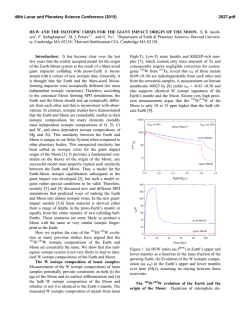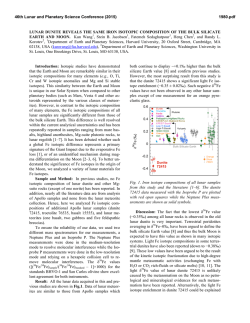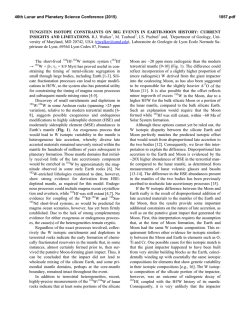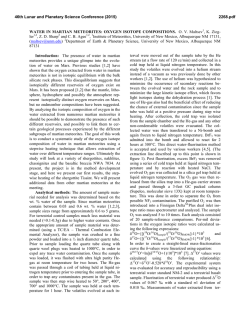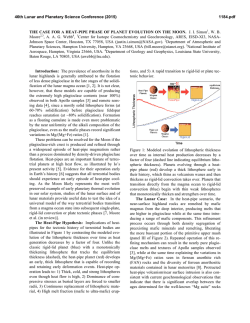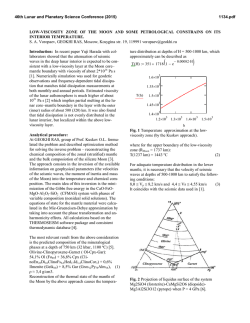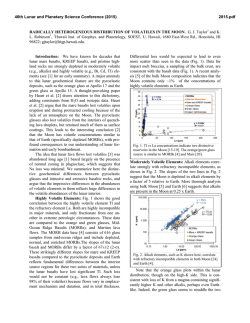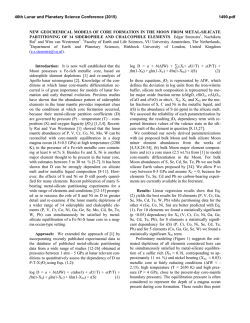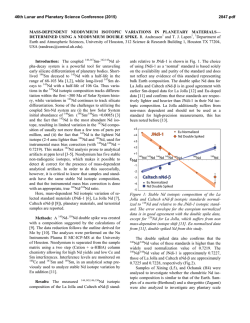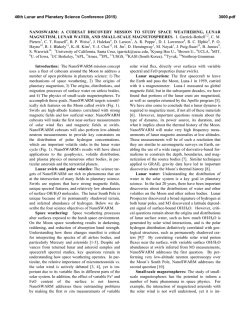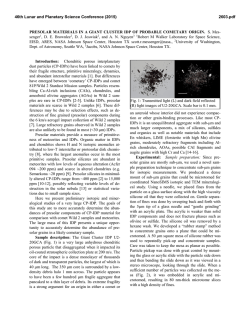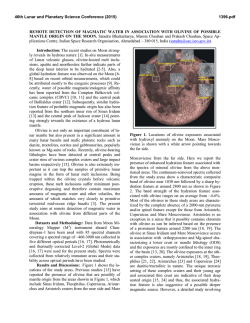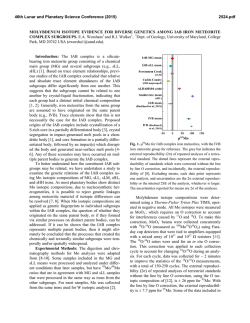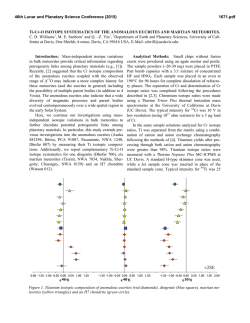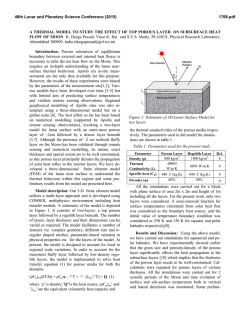
Testing Earth-Moon Isotopic Homogenization with Calcium-48
46th Lunar and Planetary Science Conference (2015) 2436.pdf TESTING EARTH-MOON ISOTOPIC HOMOGENIZATION WITH CALCIUM-48. N. Dauphas1, J.H. Chen2, D.A. Papanastassiou2,3, 1Origins Lab, Department of the Geophysical Sciences and Enrico Fermi Institute, The University of Chicago, USA ([email protected]), 2Science Division, Jet Propulsion Laboratory, Caltech, Pasadena, USA, 3Division of Geological and Planetary Sciences, Caltech, USA [11]. In this study, we report measurements of the 48 Ca/44Ca ratio in lunar samples after correction of mass-fractionation using internal normalization (i.e., the study is focused on non-mass dependent isotope effects). Early measurements on lunar samples [18] showed small surface-correlated Ca isotope fractionation in the leachates of a lunar soil, of up to 4 ‰ for 40Ca/44Ca. This Ca isotope fractionation was similar to, but far less than surface-correlated isotope fractionation effects for O and Si. These were attributed primarily to preferential gravitational loss of the lighter isotopes, due to micrometeorite impacts. The 48Ca/44Ca ratios (normalized to 42Ca/44Ca = 0.31221) in two lunar samples reported by Russell et al. [18] were identical within limits of error to the terrestrial value. We analyzed some of the same lunar whole rock samples, on which Zhang et al. [11] reported Ti data. Methodology: The chemical separation and mass spectrometric measurement of Ca isotopes were performed at the Jet Propulsion Laboratory using the methods described in [15]. During this work, repeated measurements of the NIST SRM915a standard and parallel analyses of 3 geostandards (BCR-2, BIR-1 and BHVO-2) were also carried out. Some of the results were presented in [15]. 10 Lunar Samples 0 εiCa Introduction: The Moon is generally thought to have formed from the debris of a massive, off-center collision of the proto-Earth with a smaller planet (a Mars-sized object, dubbed Theia) towards the end of accretion [1-3]. This formation mechanism addresses the angular momentum of the Earth-Moon system but results in the Moon being dominated by contributions from the impactor. It was shown recently that the angular momentum problem can be addressed separately by tidal effects on the Moon by the Sun [4], with a consequence that other scenarios are acceptable, such as impact of a small embryo with a fast spinning Earth [4] or impact between two equal size bodies [5]. The aftermath of the giant impact with the Earth has also received renewed attention. Namely, it was suggested that the terrestrial magma ocean and protolunar disk were able to exchange chemically and isotopically [6,7]. This theoretical work was motivated to a large extent by the observation that the Earth and Moon seem to have identical or very similar isotopic signatures in O, Si, Ti, W, and Cr [8-13]. These results are difficult to reconcile with the classic giant impact model of lunar formation that predicts that most of the Moon must have come from the impactor. Indeed, if the impactor had different isotopic composition than the Earth, which some have argued is likely [6,7], then one would expect lunar rocks to have non-terrestrial isotopic compositions for these elements, which is not observed. To solve this problem, Pahlevan and coworkers [6,7] argued that the Earth and Moon were isotopically homogenized in the aftermath of the giant impact. A potential test of this model is to compare the isotopic compositions of lunar and terrestrial rocks for refractory elements that would not have easily been exchanged, such as Ca or Ti. Titanium isotopes are particularly important because previous work revealed large variations in 50Ti/47Ti ratios in bulk meteorites [11,14]. Whereas all terrestrial rocks have identical 50 Ti/47Ti ratios, some bulk meteorites show deviations from the terrestrial ratio of up to 0.05 %. More importantly, Zhang et al. [11] showed that after correcting for cosmic radiation effects, the Earth and Moon are identical in their Ti isotopes. It is important to check whether the same holds true for another refractory major element on the Moon. Calcium is a perfect target to study the question of the Earth-Moon isotopic homogenization because anomalies have been reported in bulk meteorites for 48Ca [15-17] and calcium is a highly refractory element, so the predicted equilibration timescale between the Earth and Moon is long 1.5 1.0 15016 15556 70017 72155 75075 79155 0.5 -10 0.0 -0.5 -1.0 -20 42 42 43 43 44 45 44 46 47 iCa 45 48 46 47 48 Figure 1. Calcium isotopic compositions of lunar samples. The blue dashed line is the envelope corresponding to the long-term external reproducibility of the measurements, estimated based on replicate analyses of SRM915a. Results: The results are reported as εiCa=[(iCa/44Ca)sample/(iCa/44Ca)SRM915A-1]×104. Mass fractionation was corrected by internal normalization to a fixed 42Ca/44Ca = 0.31221, using the exponential law. Uncertainties are 95% confidence levels (2σ). The long term reproducibility of ε48Ca measure- 46th Lunar and Planetary Science Conference (2015) ments, as inferred from repeated analyses of SRM915a, is ~0.5 ε. Since we do not propagate the uncertainty on the standard in εiCa to each sample, we should compare the data with the error envelope for the standard (Fig. 1). If we consider the errors of the standard then all samples plot within the error envelope of the terrestrial composition (ε43Ca, ±0.4 εu; ε46Ca, ±12 εu and ε48Ca, ±0.5 εu). No correlation is found between ε48Ca and ε50Ti, suggesting that 48Ca does not suffer from the presence of cosmogenic effects in lunar samples. Taking all lunar samples together, we estimate a weighted mean ε48Ca for the Moon of -0.24±0.24. Discussion: A difficulty with the standard giant impact model of the formation of the Moon is that the Moon is made mostly of impactor material [3]. Therefore, any isotopic difference between the Moonforming impactor and the proto-Earth should have been inherited and the Moon should be distinct isotopically from the Earth [6]. A solution to this problem is that the protolunar disk and terrestrial magma ocean were able to exchange isotopically, so that any isotopic difference between the two bodies was erased [6,7]. The rate of exchange between the magma disk and the vapour atmosphere is sensitive to element volatility, as it depends on the vapour pressure of the element considered [11,19]. The exchange timescale for Ti at 3000 K is ~1 year [11]. This calculation was done assuming that the activity coefficient of Ti in the melt was ~1, which seems to be appropriate for a melt of perovskite composition [19] but it remains to be checked if this also applies to silicate melt compositions. For Ca, the equilibration timescale is much longer (27 years, or more if the activity coefficient is smaller than one, or at lower T), so 48Ca anomalies can potentially provide tighter constraints on Earth-Moon equilibration scenarios [11]. The 48Ca anomalies measured in meteorites range between -2 in ureilites and +4 in CO/CV carbonaceous chondrites [15]. We have found that lunar rocks match the Earth in their 48Ca isotopic compositions to within ~0.24 ε-units. Given its refractoriness, it is unlikely that Ca was isotopically homogenized by the scenario advocated by [6,7]. If 80 % of the Moon is derived from the impactor, the match between the Earth and Moon requires that the impactor match the protoEarth ε48Ca value to within ~0.3 ε units, which is 1/20th of the isotopic variations documented in bulk meteorites [15]. Because Ti isotopes can be measured with better precision (based on their higher abundances), the impactor had to match the protoEarth value within 1/120th of the 50Ti variations documented in bulk meteorites. 48 Ca and 50Ti are correlated in meteorites [15-17], so that if the impactor matched the proto-Earth for one isotope, the other isotope would also have been identi- 2436.pdf cal. Much of the recent theoretical work aimed at explaining the isotopic similarity between the protoEarth and the Moon supposes that the impactor had different isotopic composition than the Earth [6,7]. However, the degree of isotopic heterogeneity within 1.5 A.U., where most of Earth-forming material would have been sourced and where the Moon-forming impactor would have probably originated, is unknown. Dauphas et al. [20] made the case the inner solar system was isotopically uniform, similar isotopically to enstatite chondrites, a reservoir that they named IDUR for Inner Disk Uniform Reservoir. The existence of such a reservoir would naturally explain why the terrestrial isotopic composition is well matched by the composition of a particular type of chondrites (enstatite) and the Moon. The similarity in Si isotopic compositions of the Earth and Moon is well explained by the fact that the heavy Si isotopic composition of the silicate Earth is due to nebular fractionation rather than partitioning of Si in Earth’s core [21]. Conclusion: The 48Ca isotopic compositions of lunar and terrestrial rocks are identical within 0.24 εunits. Calcium is a highly refractory element that would not have been easily homogenized isotopically between the terrestrial magma ocean and protolunar disk. Most likely, the impactor (Theia) had the same isotopic composition as the proto-Earth because both were sourced from the same IDUR reservoir. Acknowledgements. Analytical work was performed at Jet Propulsion Laboratory, California Institute of Technology. Government sponsorship acknowledged (supported by NASA 811073.02.02.04.69). References: [1] Cameron A.G.W. and Ward W.R. (1976) LPS VII, 120-122. [2] Hartmann W.K. and Davis D.R. (1975) Icarus, 24, 504-514. [3] Canup R.M. (2004) Icarus, 168, 433-456. [4] Cuk M. and Stewart S.T. (2012) Science, 338, 1047-1052. [5] Canup R.M. (2012) Science, 338,1052-1055. [6] Pahlevan K. and Stevenson D.J. (2007) EPSL, 262, 438-449. [7] Pahlevan K., Stevenson D.J. and Eiler J.M. (2011) EPSL, 301, 433-443. [8] Clayton R.N. and Mayeda T.K. (1996) GCA, 60, 1999-2017. [9] Armytage R.M.G. et al. (2012) GCA, 77, 504-514. [10] Fitoussi C. and Bourdon B. (2012) Science, 335,1477-1480. [11] Zhang J. et al. (2012), Nature Geoscience, 5, 251-255. [12] Touboul M. et al. (2007) Nature 450, 1206-1209. [13] Lugmair G.W. and Shukolyukov A. (1998) GCA, 62, 2863-2886. [14] Trinquier et al. (2009) Science 324, 374-376. [15] Dauphas N., et al. (2014) EPSL, 407,96-108. [16] Chen H.-W. et al. (2011) ApJL 743, #L23. [17] Schiller M. et al. (2015) GCA 149, 88102. [18] Russell W.A. (1997) LPSC Proc. VIII, 3791-3805. [19] Zhang J. et al. (2014) GCA 140, 365-380. [20] Dauphas N. et al. (2014) Phil. Trans. R. Soc. A 372, 20130244. [21] Dauphas N. et al. (2015) LPSC 46, #1417.
© Copyright 2026
